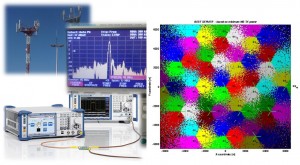The future of wireless and mobile communications is known as 5G, and service providers all around the world will require professionals with the know-how and fundamentals of design, planning and implementing 5G technology.
If you would like to to get involved and acquire these fundamentals to be part of the technological revolution, you must get involved in this project. RF measurement equipment and some electronic programmable hardware will be used to carry out measurements on the field.
DESCRIPTION
Recently, wireless communication systems have increased significantly, by facilitating our daily lives, by being always connected with others and the environment. Yet, future technologies and devices, require analysis and solutions to important problems as capacity and coverage, because more users and more devices will require connectivity with high capacity, high speed and wide coverage. 5G mobile network technology emerges as the technology that will solve these challenges and give greater coverage and ability to all users. However, it is still not well defined since it is still a work in progress from the standards point of view. Therefore, this activity proposes the challenge of analyzing and designing a radio frequency planning method for a system with 5G radio technology.
The development of the project forms the basis on which manufacturers conduct feasibility studies to propose solutions to service providers, and unlike courses taken throughout your undergraduate degree, the participants will pose a design solution, according to requirements, that solve challenges and show the recovery of investment in the project.
The first phase of the activity will be to read and analyze the main ideas of topics on radio planning. Also, to take spectrum measurements with radio frequency equipment, and develop a conceptual map of important ideas of the subject. Then there will be a part where network planning for any geographic area as the city of Monterrey will be carried out with analysis of the location of base stations from different companies, coverage and capacity in places of the city. This will provide maps of the city and information of the companies of the location of their base stations.
In the second phase, the most important features of the 5G technology will be analyzed by comparing it with the current 4G and 3G technologies. Subsequently, participants will establish the fundamentals of a methodology for the new cellular network radio design 5G. Issues such as the number of users to be connected at different points of the city, new buildings that require higher density of users, major areas of coverage that are not currently covered, etc. will be taken into consideration. Participants will develop a work plan, as if it were a real company, and formulate a possible design solution, and how the recovery of investment in the project will be. During this second phase, will be a visit to the company Axtel, which will show facilities, will present typical problems, and will explain the requirements for the implementation of the design. Measurements with different equipment will be taken for later comparison with simulations.
In the third phase of the activity, participants, in groups, will present their solutions, will discuss it and will discuss from the perspective of the different points of view.
With this activity, the participant can identify reasons to problems such as that of places where users cannot communicate using mobile devices. Also an analysis of why it happens and how to find solutions with new technologies will be a part of the project. The participant will develop the radio frequency planning of the cellular system considering a new emerging technology as if from a real company were. And this will provide you with the knowledge needed to confront real issues in telecommunication companies in the future.
OBJECTIVES
The overall objective is the radio design of the cellular system in the city of Monterrey using an emerging technology as 5G. To identify the most important factors when designing a system. To analyze problems and possible solutions. To design the system for its possible implementation.
The pedagogical elements that will be used during the activity are: data analysis, information search, simulations, research, comparison and contrast, discussion, report development.
In terms of technology, transmission and reception equipment of electromagnetic waves will be used for radio frequency measurements prior to the radio design. Data analysis with software such as Matlab. Use of tools to develop the Group report (Power Point, Word, Excel) and use of the Blackboard platform for the delivery of the activity.
DELIVERABLES
- Map of geographical area resulting from the design, indicating the location of base stations
- Coverage map of each one of the base stations resulting from propagation calculations.
- Presentation and software routines for the radio frequency design and planning for the signal propagation study that works with your proposal.
- Technical report detailing the development process and results
REQUIREMENTS
Undergraduate studies in programs such as ITE, IMT, ITM, ITS, ITC, ISD, with at least the course on Signals and Systems Analysis.
DURATION AND DATES
One week, September 26 – 30, 2016.


